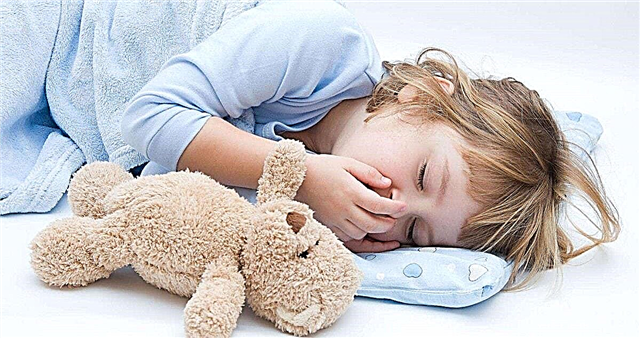If a child is bleeding from the ear, the parents are very worried. Especially when it is not due to obvious reasons (scratching, etc.). Is it always worth worrying about such unpleasant symptoms, what should be done?

The child has a sore ear
Features of the structure of the baby's ear
Ears are hearing organs that help a child to perceive the world around him correctly. This body cannot be called too vulnerable, but it must be treated carefully. The vessels providing blood circulation in the ear are very thin and take a long time to recover.
Anatomically, the ear consists of three parts:
- The outer part, or outer ear, forms the external auditory canal. In newborns, it is poorly developed, short and narrow. The external auditory canal ends with the eardrum, which protects the inner ear. The eardrum in infants is located almost horizontally and forms an angle of 10-20 ° with the lower wall of the ear canal. As the child develops, the lumen of the external auditory canal gradually increases;

Differences between adult and child ear
- The middle ear is located directly behind the eardrum and is formed by the tympanic cavity and the auditory tube.
Important! The walls of the tympanic cavity in children of the first year of life are thin; in some areas, connective tissue is present instead of bones. Because of this, unlimited spread of the infection is possible.
- Inner ear. The most difficult part consists of the bony and membranous labyrinth and fluid that transmits sound vibrations to the auditory nerves.
At the time of the baby's birth, the middle ear cavity consists of embryonic myxoid tissue, which is absorbed in the first year of life. Its presence is the reason for the appearance of folds that prevent the outflow of pus during otitis media. Myxoid tissue is a good breeding ground for bacterial microflora, which is a common cause of otitis media in infants.
In newborns, the auditory tube is flush with the horizontal plane of the hard palate and the lower end of the nasal cavity. Children usually lie on their backs, this anatomical structure allows nasopharyngeal mucus to easily penetrate into the tympanic cavity.
Causes of ear bleeding
The causes of blood from the ear in a child are different: from relatively harmless to serious pathologies.
Traumatic injury
Injury due to trauma is divided into several groups:
- Cranial. Such injuries often cause ear bleeding;
- If you carelessly and incorrectly clean your ears, you can easily damage them, then blood will begin to flow;

Ears may be damaged when cleaning
- The kid can get mechanical damage while playing active games. A strong blow to the ear, such as a ball, can damage the eardrum and cause inflammation, causing blood to develop.
Oncological diseases
Benign and malignant neoplasms almost always cause ear bleeding, which is often their first visible symptom.
Important! Benign tumors also need to be treated urgently because as they grow, the tympanic membrane is severely compressed, which can damage it.
If blood from a child's ear appears due to an oncological disease, then the baby will need careful observation and diagnosis to determine the nature of the tumor and treatment.
Pressure change
Abrupt changes in blood pressure are rare in infants. As a rule, its increase occurs against the background of other pathologies, for example, renal diseases. Sometimes this can cause blood to flow from the ear.
Foreign body in the ear
A small child, playing, can easily stick a foreign body into the ear. Sometimes insects can crawl there. Sharp objects are especially dangerous in a child's ear, which can not only scratch the skin, but also damage the eardrum. That is why it is strictly forbidden to get a foreign body using tweezers, a paper clip and even a cotton swab. Only a specialist can safely remove the item.
Infectious diseases
The most common reason that blood appears in a child's ear is diseases caused by various infections:
- The formation of purulent formations - boils, which are usually found in the outer ear, when they are opened, pus and blood flow out;
- Myringitis is a disease in which the eardrum becomes inflamed;
- Fungal otitis media (candidiasis). Babies may have inflammatory diseases (chronic tonsillitis, sinusitis), when immunity decreases.
Important! Often, candidiasis develops due to the presence of abrasions, which can lead to the habit of frequently and inadvertently cleaning the ears.
- Otitis media (ear inflammation). It is often caused by the same viruses that trigger the common cold. The disease is accompanied by pain, fever, vomiting, irritability, cough, sleep disturbances, loss of appetite, sometimes pus or fluid containing blood flows from the ear. Small children, up to one year old, who cannot speak, can constantly pull or touch their ears, often turn their heads.
When to see a doctor
In all cases of ear bleeding, especially if the cause is unclear, it is necessary to consult a doctor. When blood appears in the child's ear during brushing, it may be due to injury to the ear canal. To exclude damage to the eardrum, it is also best to see a specialist.

Inspection of the baby's ears
Possible complications
Otitis media is a disease that causes serious complications if untimely or incorrect therapy. Children's doctor Komarovsky advises not to use any folk remedies for his treatment, but immediately consult a doctor. Complications of otitis media:
- Otogenic meningitis. It develops more often due to chronic otitis media, less often due to acute purulent;
- Chronic ear infections can lead to hearing loss and hearing loss. In inflammatory processes, ruptures of the tympanic membrane occur, even if they overgrow, scars form;
- Polyps are benign neoplasms that grow against the background of chronic otitis media.
Preventive actions
Which increases the risk of an ear infection:
- frequent colds;
- sucking a bottle while lying horizontally on your back;
- tobacco smoke;
- artificial feeding;
- untimely vaccination.
Since bleeding due to trauma often occurs when trying to clean the ears with various objects, then to exclude such cases it is necessary to take the following preventive measures:
- To reduce the production of earwax, avoid giving your baby foods high in sugar;
- In order to clean the ears, it is necessary to rinse. However, the need for this procedure is determined by the doctor, it is better to carry it out under his supervision.
Important! You cannot clean the baby's ears with any objects, including cotton swabs, which do more harm than good. Baby's skin is very delicate and easily damaged. If necessary, you can use a flagellum twisted from cotton wool.

Cleaning the ears with a flagellum
To protect against colds and their complications, you need to put on the child a hat that covers the ears when going for a walk, if it is cold outside or the wind is blowing.
Ear bleeding is much less common than others. It can signal inflammation, injury and other problems that require immediate medical attention. The more intensively the blood goes, the faster you need to seek medical help.



